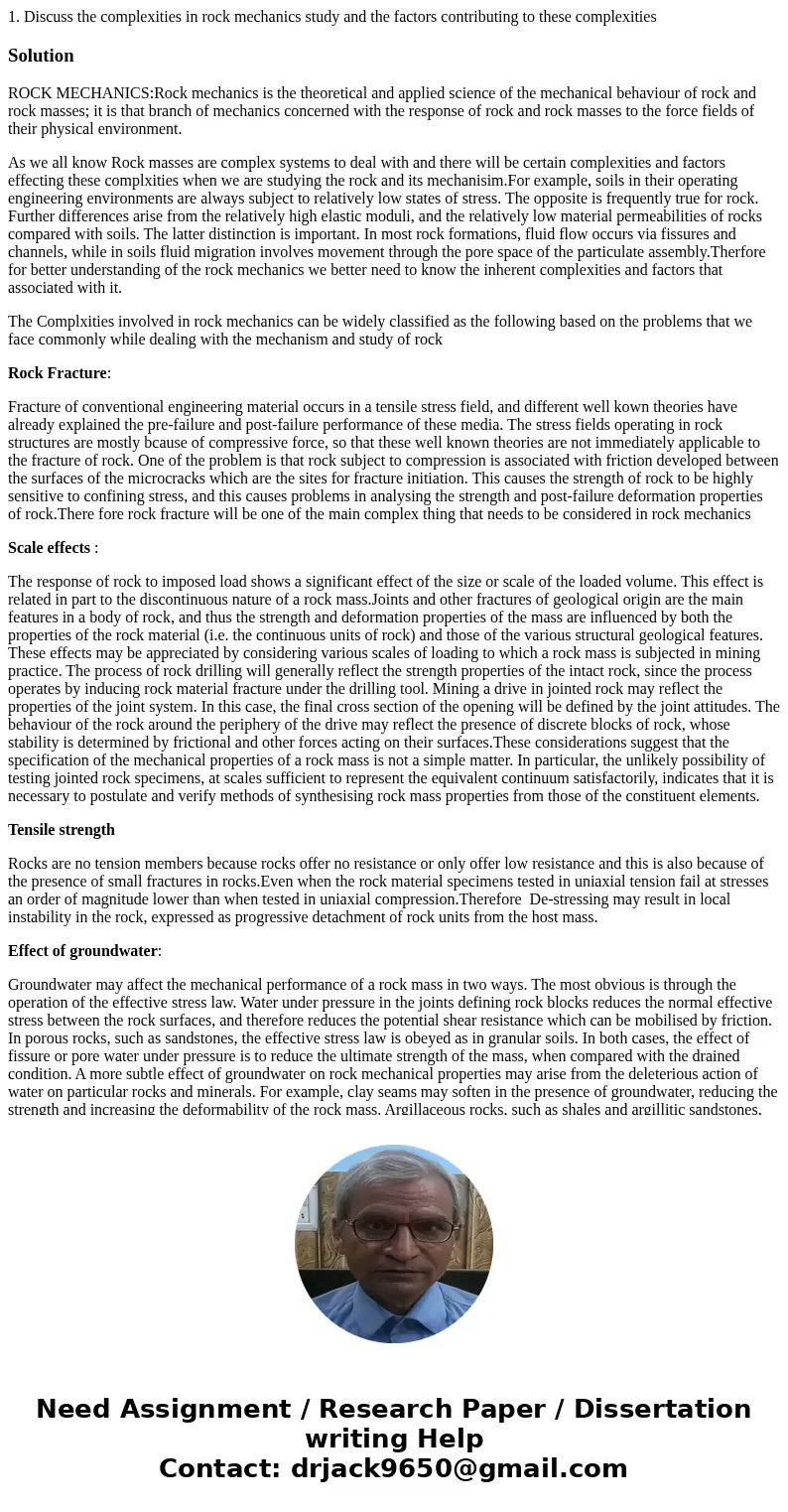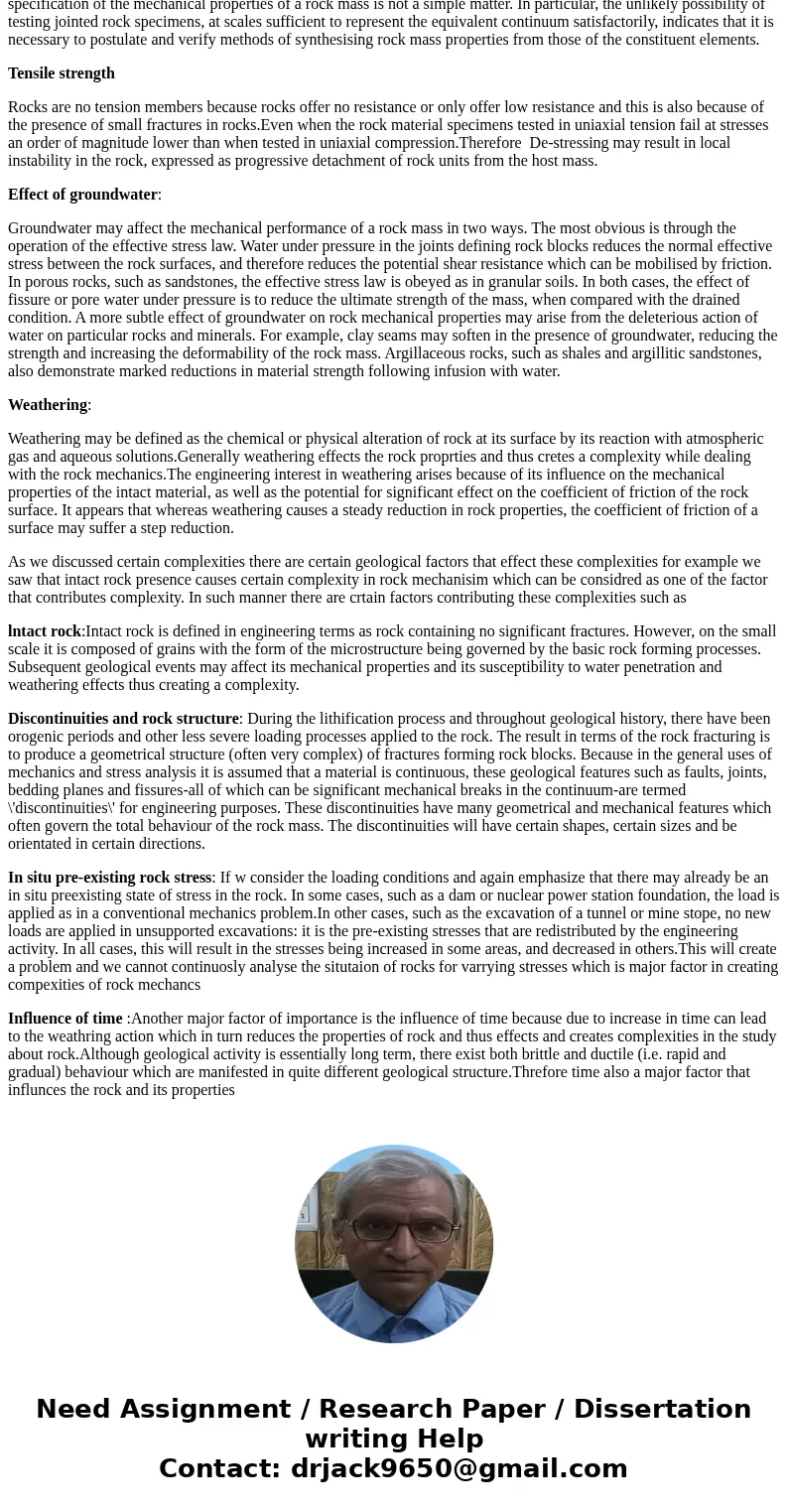1 Discuss the complexities in rock mechanics study and the f
Solution
ROCK MECHANICS:Rock mechanics is the theoretical and applied science of the mechanical behaviour of rock and rock masses; it is that branch of mechanics concerned with the response of rock and rock masses to the force fields of their physical environment.
As we all know Rock masses are complex systems to deal with and there will be certain complexities and factors effecting these complxities when we are studying the rock and its mechanisim.For example, soils in their operating engineering environments are always subject to relatively low states of stress. The opposite is frequently true for rock. Further differences arise from the relatively high elastic moduli, and the relatively low material permeabilities of rocks compared with soils. The latter distinction is important. In most rock formations, fluid flow occurs via fissures and channels, while in soils fluid migration involves movement through the pore space of the particulate assembly.Therfore for better understanding of the rock mechanics we better need to know the inherent complexities and factors that associated with it.
The Complxities involved in rock mechanics can be widely classified as the following based on the problems that we face commonly while dealing with the mechanism and study of rock
Rock Fracture:
Fracture of conventional engineering material occurs in a tensile stress field, and different well kown theories have already explained the pre-failure and post-failure performance of these media. The stress fields operating in rock structures are mostly bcause of compressive force, so that these well known theories are not immediately applicable to the fracture of rock. One of the problem is that rock subject to compression is associated with friction developed between the surfaces of the microcracks which are the sites for fracture initiation. This causes the strength of rock to be highly sensitive to confining stress, and this causes problems in analysing the strength and post-failure deformation properties of rock.There fore rock fracture will be one of the main complex thing that needs to be considered in rock mechanics
Scale effects :
The response of rock to imposed load shows a significant effect of the size or scale of the loaded volume. This effect is related in part to the discontinuous nature of a rock mass.Joints and other fractures of geological origin are the main features in a body of rock, and thus the strength and deformation properties of the mass are influenced by both the properties of the rock material (i.e. the continuous units of rock) and those of the various structural geological features. These effects may be appreciated by considering various scales of loading to which a rock mass is subjected in mining practice. The process of rock drilling will generally reflect the strength properties of the intact rock, since the process operates by inducing rock material fracture under the drilling tool. Mining a drive in jointed rock may reflect the properties of the joint system. In this case, the final cross section of the opening will be defined by the joint attitudes. The behaviour of the rock around the periphery of the drive may reflect the presence of discrete blocks of rock, whose stability is determined by frictional and other forces acting on their surfaces.These considerations suggest that the specification of the mechanical properties of a rock mass is not a simple matter. In particular, the unlikely possibility of testing jointed rock specimens, at scales sufficient to represent the equivalent continuum satisfactorily, indicates that it is necessary to postulate and verify methods of synthesising rock mass properties from those of the constituent elements.
Tensile strength
Rocks are no tension members because rocks offer no resistance or only offer low resistance and this is also because of the presence of small fractures in rocks.Even when the rock material specimens tested in uniaxial tension fail at stresses an order of magnitude lower than when tested in uniaxial compression.Therefore De-stressing may result in local instability in the rock, expressed as progressive detachment of rock units from the host mass.
Effect of groundwater:
Groundwater may affect the mechanical performance of a rock mass in two ways. The most obvious is through the operation of the effective stress law. Water under pressure in the joints defining rock blocks reduces the normal effective stress between the rock surfaces, and therefore reduces the potential shear resistance which can be mobilised by friction. In porous rocks, such as sandstones, the effective stress law is obeyed as in granular soils. In both cases, the effect of fissure or pore water under pressure is to reduce the ultimate strength of the mass, when compared with the drained condition. A more subtle effect of groundwater on rock mechanical properties may arise from the deleterious action of water on particular rocks and minerals. For example, clay seams may soften in the presence of groundwater, reducing the strength and increasing the deformability of the rock mass. Argillaceous rocks, such as shales and argillitic sandstones, also demonstrate marked reductions in material strength following infusion with water.
Weathering:
Weathering may be defined as the chemical or physical alteration of rock at its surface by its reaction with atmospheric gas and aqueous solutions.Generally weathering effects the rock proprties and thus cretes a complexity while dealing with the rock mechanics.The engineering interest in weathering arises because of its influence on the mechanical properties of the intact material, as well as the potential for significant effect on the coefficient of friction of the rock surface. It appears that whereas weathering causes a steady reduction in rock properties, the coefficient of friction of a surface may suffer a step reduction.
As we discussed certain complexities there are certain geological factors that effect these complexities for example we saw that intact rock presence causes certain complexity in rock mechanisim which can be considred as one of the factor that contributes complexity. In such manner there are crtain factors contributing these complexities such as
lntact rock:Intact rock is defined in engineering terms as rock containing no significant fractures. However, on the small scale it is composed of grains with the form of the microstructure being governed by the basic rock forming processes. Subsequent geological events may affect its mechanical properties and its susceptibility to water penetration and weathering effects thus creating a complexity.
Discontinuities and rock structure: During the lithification process and throughout geological history, there have been orogenic periods and other less severe loading processes applied to the rock. The result in terms of the rock fracturing is to produce a geometrical structure (often very complex) of fractures forming rock blocks. Because in the general uses of mechanics and stress analysis it is assumed that a material is continuous, these geological features such as faults, joints, bedding planes and fissures-all of which can be significant mechanical breaks in the continuum-are termed \'discontinuities\' for engineering purposes. These discontinuities have many geometrical and mechanical features which often govern the total behaviour of the rock mass. The discontinuities will have certain shapes, certain sizes and be orientated in certain directions.
In situ pre-existing rock stress: If w consider the loading conditions and again emphasize that there may already be an in situ preexisting state of stress in the rock. In some cases, such as a dam or nuclear power station foundation, the load is applied as in a conventional mechanics problem.In other cases, such as the excavation of a tunnel or mine stope, no new loads are applied in unsupported excavations: it is the pre-existing stresses that are redistributed by the engineering activity. In all cases, this will result in the stresses being increased in some areas, and decreased in others.This will create a problem and we cannot continuosly analyse the situtaion of rocks for varrying stresses which is major factor in creating compexities of rock mechancs
Influence of time :Another major factor of importance is the influence of time because due to increase in time can lead to the weathring action which in turn reduces the properties of rock and thus effects and creates complexities in the study about rock.Although geological activity is essentially long term, there exist both brittle and ductile (i.e. rapid and gradual) behaviour which are manifested in quite different geological structure.Threfore time also a major factor that influnces the rock and its properties


 Homework Sourse
Homework Sourse